Everybody needs to clean their glass eventually. Adam R. shows us how to easily remove 100% of resin without getting dirty or using expensive solutions.
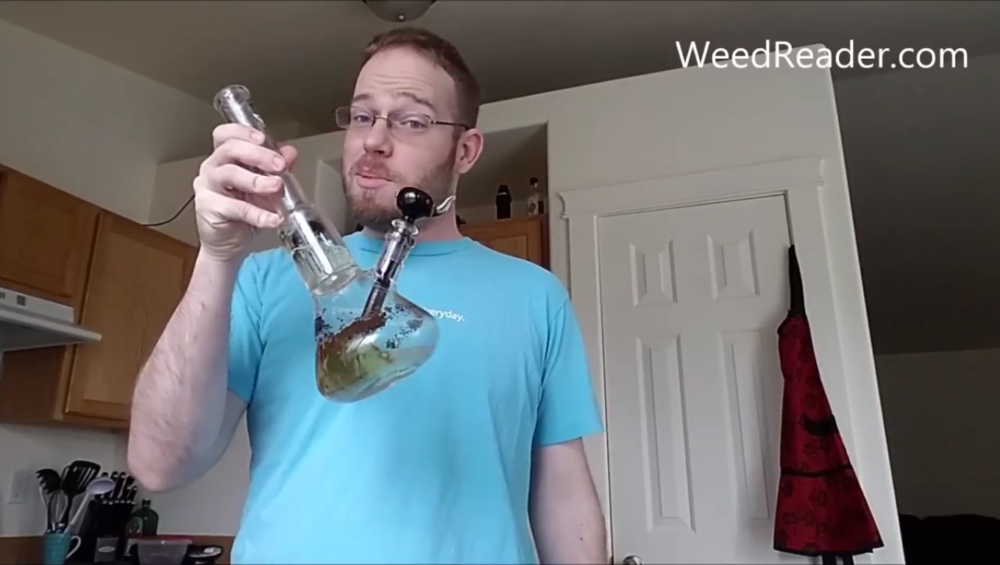

Everybody needs to clean their glass eventually. Adam R. shows us how to easily remove 100% of resin without getting dirty or using expensive solutions.
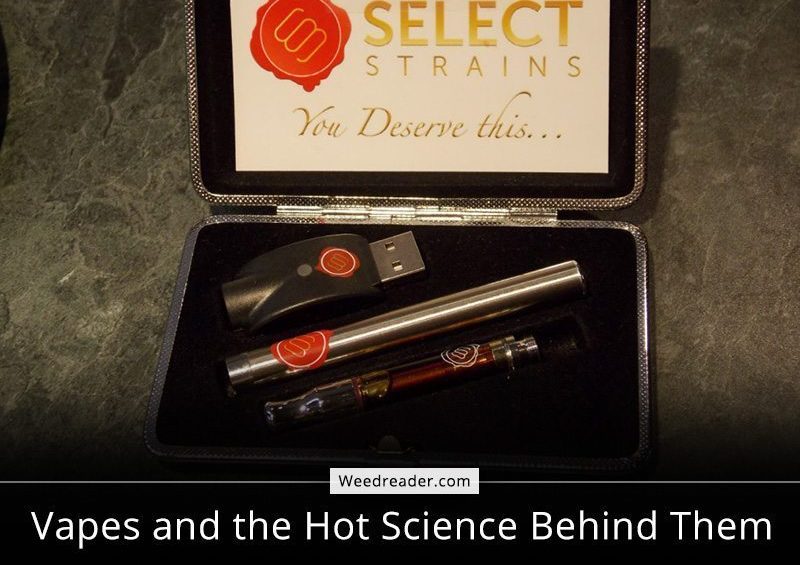
Vaporizing or “vaping” has become one of the most popular ways to consume cannabis in recent years. Where old-school cannabis consumers would smoke plant matter, designers and engineers decided to vaporize the cannabis instead of burn it. The devices they created are referred to as vapes. These vapes come in a variety of shapes, power and styles and are one of the most commonly sold items in dispensaries across the nation. While there are stationary vaporizers, most of the industry is dedicated to portable devices.
One reason that portable vapes have become so common is because they are often much more discreet than smoking. Instead of creating a skunky, thick smoke that hangs in the air and clings to your body, vaporizers create an aerosol-like cloud that dissipates quickly and doesn’t linger.
Vaping is perfect for discreet or mobile cannabis consumption. For those who need to get high and then go back to dinner with grandma or at a concert, a vaporizer is the method of choice. The popularity of commercial nicotine-based vapes or “e-cigs” makes identifying a stoner in a group of vapers almost impossible.
When most people think of an electronic cigarette, they think of regular old, retro e-cigs. You buy them at a gas station, and (Vuze and Blu are two popular brands) they are made by tobacco companies. This part of the market is dominated by tobacco companies like Imperial Tobacco and RJ Reynolds. The cartridges in these vapes come pre-filled and are disposable.
In an actual vape shop, you’ll find products commonly referred to as APVs—Advanced Personal Vaporizers or “Vape Pens” and “Vape Mods”. APVs are produced predominantly by companies based in China like Innokin. They contain electronics to regulate the power level, produce a moderate amount of vapor, and are generally under $100. Mods are for use with user-rebuildable atomizers, can potentially produce tons of vapor, and can be expensive.
Both Vape Pens and Mods function on battery power. The industry has embraced advances in tech like USB-Rechargable batteries. Mods tend to have larger batteries than Pens because they need to push out a lot more enery. While a Vape Pen may last an average user 2-5 days, a Mod with the same size battery might only last 1-2 days.
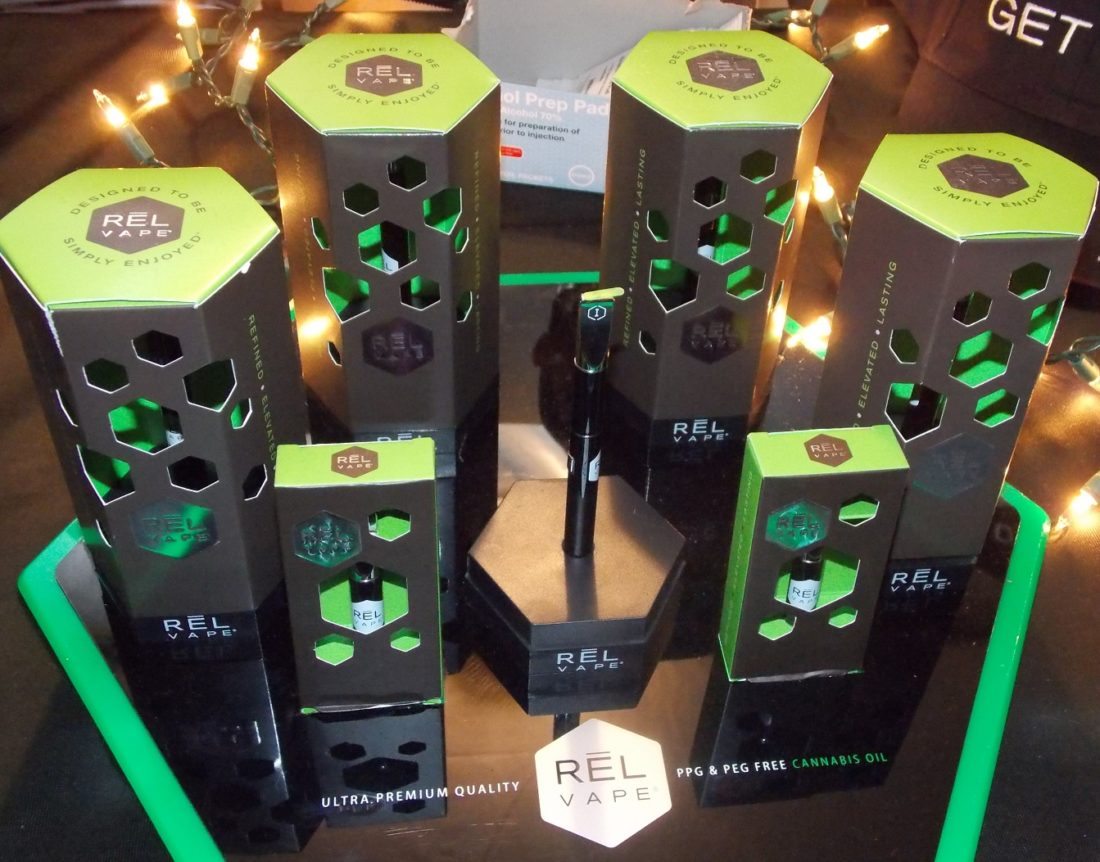
Even though using a USB-rechargeable vaporizer seems infinitely easier than loading a bowl or rolling a joint, they come with their own challenges. This is especially true in the case of flower vaporizers. Loading the tiny chamber can be a headache, as can cleaning out the vaporized plant waste with anything but a specialized tool.
Cleaning comes more often in vaporizers than traditional smoking bowls as well. This is due to the dominance of exceptionally small chambers. The small chamber is due to the high amount of energy needed to vaporize plant matter (more on that later). Also, portable vaporizers eventually run out of battery, leaving you not-so-high and dry if you forget to plug it in and don’t have a USB port available.
Vaporization does have the advantage of not actually burning the plant material, which gives a clean taste, bereft of the woody finish you get when smoking. While some users prefer this nuanced flavor, many heavy cannabis users like the increased potency and cleanliness of vaping.

Vaping is commonly seen as safer alternative to smoking. Vape cartridge or “e-liquid” begins with a vegetable glycerin base. Most manufacturers use certified organic VG. While the glycerin doesn’t carry flavor very well, it does produce a lot of vapor. Then comes is propylene glycol. propylene glycol—or PG—is a main ingredient in albuterol, or asthma inhalers, and is perfectly safe to inhale when vaporized.
Commonly mistaken as being a main ingredient in antifreeze (diethylene glycol) which has actually been found in mass market e-cig products, PG is thinner than VG, and carries flavor very well. The final ingredient is flavorings. These are commonly suspended in PG and are food-grade. Flavorings can be natural or artificial, and cannabis based vape cartridges usually include terpenes.
The final ingredients are the active ingredients. They contain pharmaceutical-grade nicotine or cannabinoids like THC and CBD. All manufacturers make products in varying strengths. Cannabis based cartridges are required to display concentration and overall volume of active ingredients.
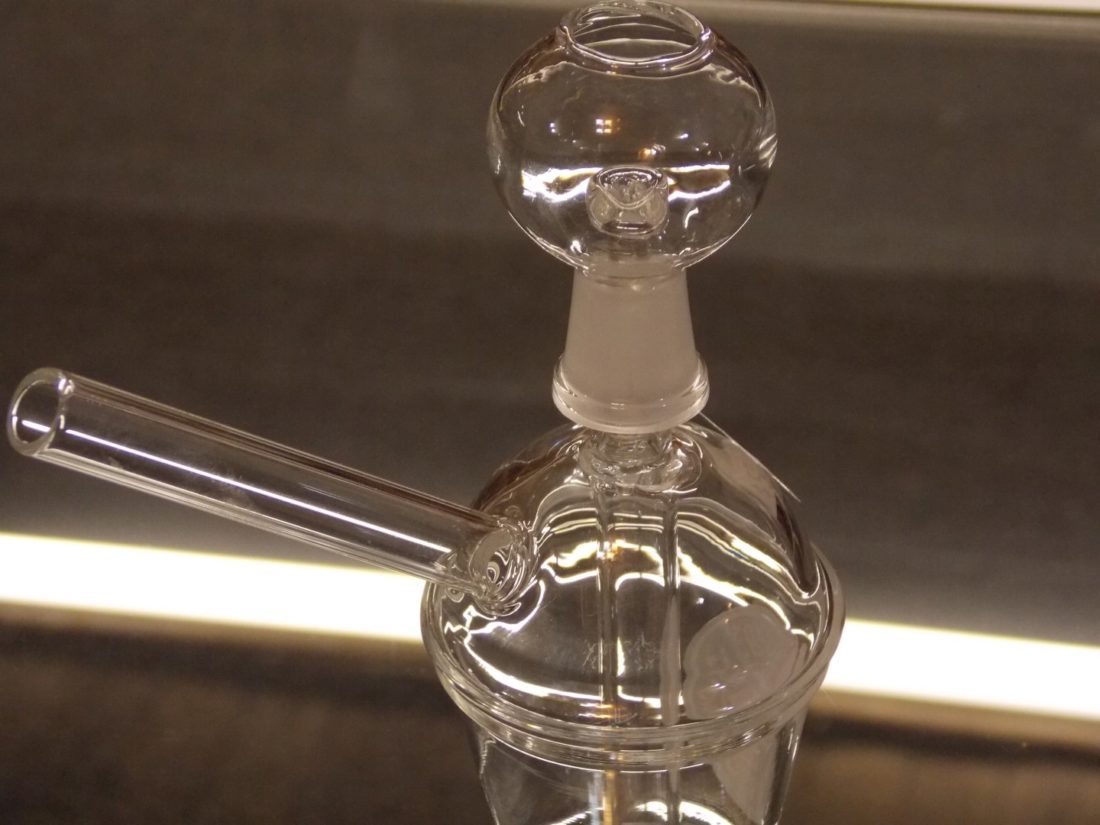
“Anything that lights the plant on fire creates respiratory irritants,” explains Dr. Mitch Earleywine, a professor and researcher at the State University of New York at Albany. When users are trying to consume cannabis in the safest way possible, there are a few things to understand about what happens to the cannabis when it’s heated. Namely, you’ll need to understand the difference between conductive and convective heating.
Conductive Heating
Vaporizers and other tools that use conduction to make cannabis smoke or vaporize typically use flower or concentrate applied directly to a hot plate. The heat changes the raw thc into a useable form and literally boils it. When dabbing, the “hot plate” is an ultra-hot metal nail that is heated to extremely high temperatures using a blowtorch.
Convective Heating
Rather than heating the cannabis matter directly with a heating plate, convective vaporizers use an electronic mechanism to heat air. Once the air reaches a certain temperature, it is forced over the plant matter/concentrate. The hot air actually heats the cannabis product, extracting the THC and turning it into a vapor without burning the substance.
Of the two types, convective vaporization is believed to be the best for your body. The convective method avoids the charring associated with nearly every other method, meaning that convective heat creates the purest form of activated, consumable cannabis vapor.

Proper vaporization releases most essential oils in the plant while it stays below the point of combustion. These essential oils contain the majority of the cannabinoids and terpenes which give cannabis its effects. In essence, vaporization gives you all the good stuff and very little of the bad.
Truth On Pot explains, “a collaborative study conducted by California NORML and MAPS found that vaporizers could convert 46 percent of available THC into vapor, whereas the average marijuana joint converted less than 25 percent of THC. Likewise, patients ranked vaporizers as the most efficient method of marijuana intake — requiring a lower dose than smoking, edibles, and tea — in a recent study published in the Journal of Psychoactive Drugs.”
Here’s a handy chart from NowSourcing that breaks down why that is even further:

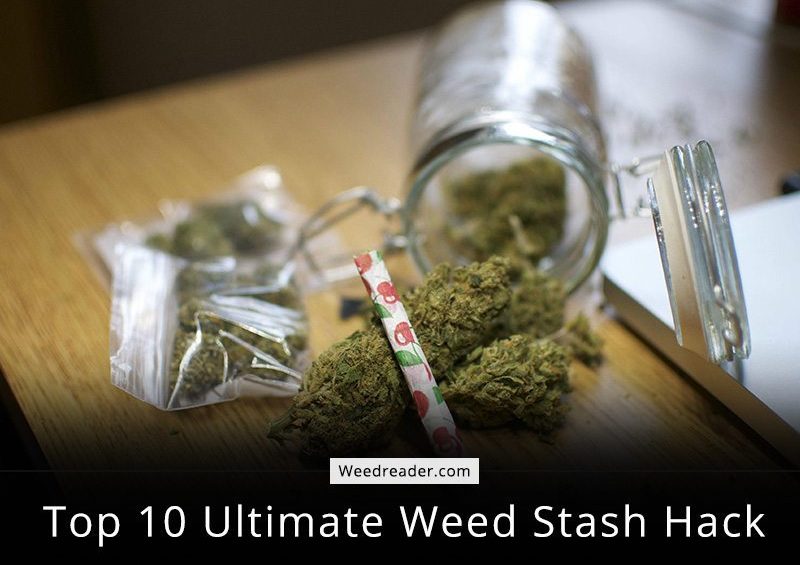
Maybe you have used similar stash hacks forever and didn’t realize others hadn’t. Whatever the case may be, here are the 10 best tricks in no specific order.
Keeping weed at the optimal hydration level (about 55-65% relative humidity) can feel downright impossible. If left exposed to the open air, valuable terpenes are lost and flower will burn fast and hot. Overly dried flower also has the bad habit of crumbling into dust. Get it too wet and it won’t even smoke or worse yet, it could start to mold!
Once a stash has succumbed to things like molds, mildew, fungi or other pathogens, it is a complete loss. Don’t even be tempted to smoke the ones you “can’t see anything wrong with” if there is any evidence of corruption. The risks are simply too great to roll that dice. Drying out is an altogether different problem though.
Once a weed is dried out, it becomes harsh and burns up significantly faster. Nobody wants to smoke old, crumbly weed. We want sticky nugs that snap apart but slightly hold their shape when shoved in a bowl. Yet cannabis can be re-hydrated and return to being sticky. Many a stash has been saved by trying one of these following hacks. I have used all of them to keep my own stash in peak condition but each has its own time and place.
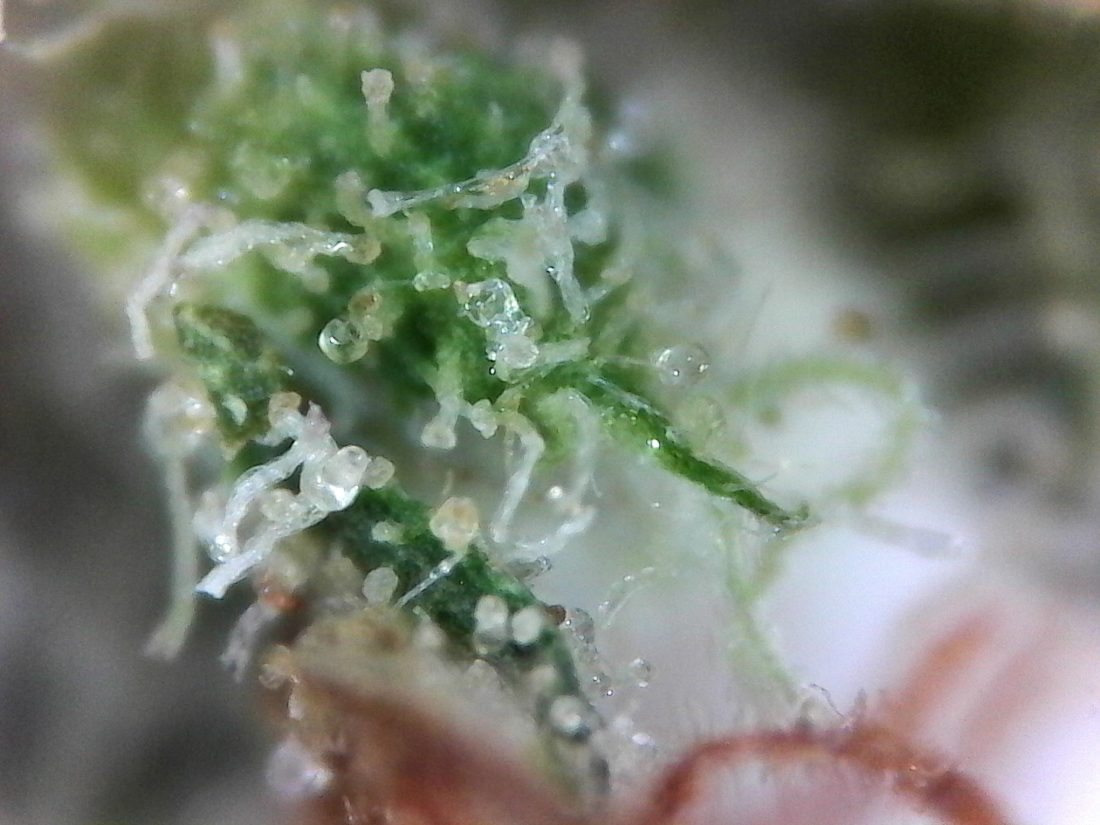
Method: Take a small bit of citrus peel and stick it in with the weed. Must use real peels, extract doesn’t do the same.
Benefits: This hack infuses the citrus terpenes (like Limonene) into the cannabis. Since the peel has a high water content way higher than cannabis where cannabis should be at, it will rehydrate a dried out stash.
Drawbacks: Lemon peels rot. When they do, it creates the perfect breeding grounds for molds, fungi and other harmful pathogens. It can also over saturate cannabis of too much is added to a stash. This has the side effect of making the weed difficult to light and produce little smoke.

Method: Simply wet a Q-tip (any cotton swab will work) and drop it in with the stash. Keep an eye on when it dries out so you can reuse or replace the swab.
Benefits: This method preserves the unadulterated taste of pure cannabis. It also provides a low cost alternative (although way less cool) to getting a humidifier. Because swabs come sterile, mold issues are kept to a minimum if replaced often.
Drawbacks: Cotton swabs are disposable for a reason. Reusing swabs leads to cross contamination and can also be a breeding ground for mold, fungi and other pathogens.
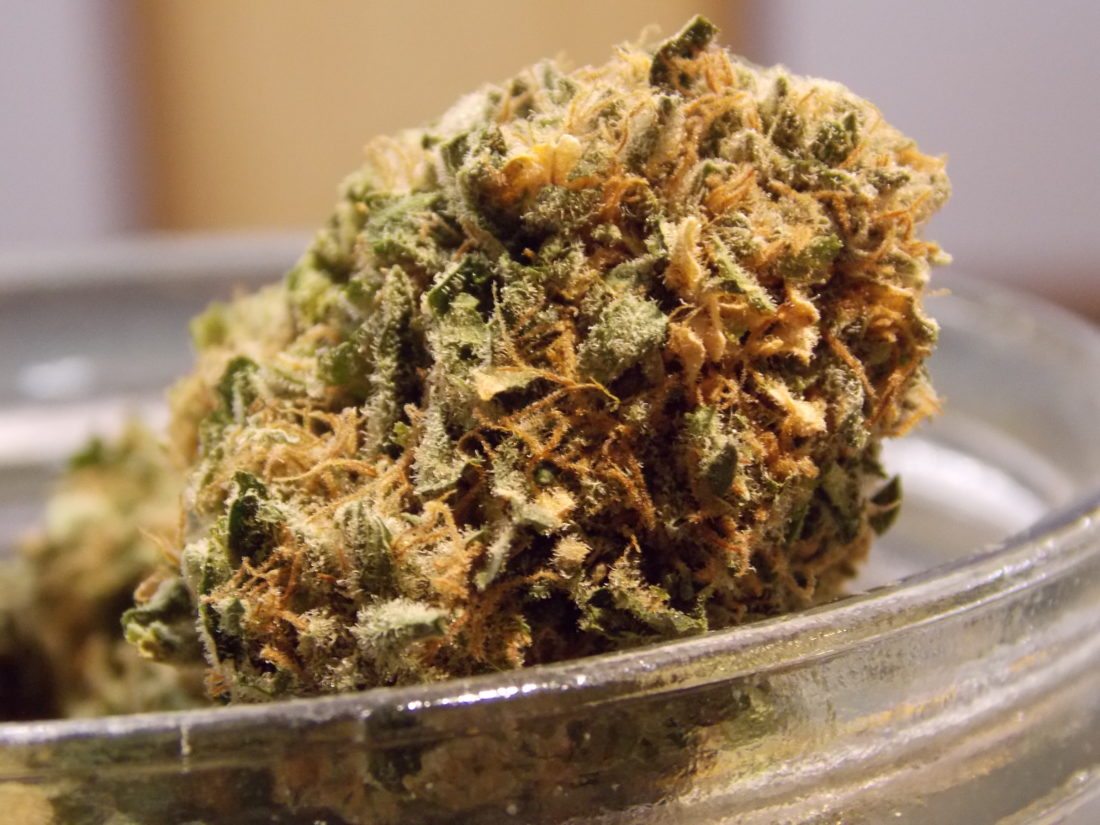
Method: Similar to the Q-Tip method except that a moist cotton ball is taped to the top of the container. Reuse or replace once it dries out.
Benefits: Taping the cotton ball to the top of the container keeps it from coming in contact with the stash. This prevents cotton fibers from getting caught in the bud and limits cross contamination. Cotton balls also come sterile so there is no risk of additional contaminants being introduced to the stash.
Drawbacks: Replacing tape over and over can get to be a chore so it is tempting to simply reuse the cotton ball for extended periods. Doing so exposes the user to the same dangers of mold, fungi and pathogens through cross contamination.
Regardless if the stash comes from a legal dispensary, a guys basement or Snoop Dogg himself, you need somewhere to store it. In the old days, Ziplock baggies were the standard. Today, people can obtain legal cannabis from dispensaries that use medicine bottles. While the medicine bottle is mandated by many states for sales, they still suck for keeping a stash. Here are a few suggestions for ways to store weed that is better than the old Ziplock or medicine bottle.

Method: this glass container is sold in most stores across the world. This is a simple glass vessel with threading that allows a metal ring and lid at the top. It is air/watertight, reusable and cheap.
Benefits: They comes in several sizes, produce and airtight and watertight seal, and are easy to store or obtain almost anywhere. In addition to that, they are easy to clean, don’t rust or otherwise break down over time.
Drawbacks: Glass is fragile and has a tendency to break when exposed to extreme temperature changes.

Method: Use two different sized containers to store your stash. The first is a small “daily” jar that keeps what you typically consume in a day. The second is “the vault” where you store your remaining cannabis. Load bowls from the daily jar and only open the vault when needed.
Benefits: This method reduces stash moisture loss from cycling the air in the jar. It helps budget or regulate the amount of product consumed in a day. This method also helps maintain stash security by not advertizing you have a pound of weed every time you load a bowl.
Drawbacks: Unnecessary if you get a jar that is too small or don’t buy more than a day or two worth of product at a time. It also adds one more step to the smoking ritual.

Method: Take any amount of cannabis you don’t plan to use immediately and put it in the freezer in a sealed container. Freezer bags are commonly used for this method. Freezing the weed prevents loss of hydration over extended periods.
Benefits: People have stored weed in freezers/fridges for years and still had a pleasant experience. Freezing cannabis makes trichomes brittle and easy to break off for ice wax and other concentrates.
Drawbacks: Just like meat, weed can get freezer burn if it is not sealed correctly. Cannabis can also be exposed to many bacteria and other pathogens from decaying food nearby (I’m looking at you Strawberries!) so keep a tight lid on it. Frozen trichomes also break off much easier than at room temperature.

Method: Instead of glass or plastic, use a silicone container. There is a wide variety available online, at dispensaries or at head shops built to suit your needs.
Benefits: Silicone wont shatter/rip/shred/cut/melt under normal use. It is even safe to touch with a warm dab tool when frozen (just not a red hot tool). Wax and other concentrates can’t stick like they do to glass or plastic. They also come in a wide variety of colors and shapes.
Drawbacks: Can be very expensive, especially when getting something airtight and cool looking.
Sometimes there is more month than money and we are faced with some hard choices. Do you share what you have and possibly spend days without THC or keep it for yourself? These tips can help you make that decision without alienating yourself or getting caught holding out. Just don’t get mad if someone else uses these tips too. It’s just a matter of making the most of what you got.

Method: This requires that you can suspend you weed in the pipe itself (best with screened metal pipe). You store a nug in the middle of the pipe so that every hit has to pass over the nug before making it into the users mouth.
Benefits: The stored nug gets coated with a layer of resin (poor man’s wax) and therefore gets additional THC added to it. It also makes it easy to carry around a second bowl for personal use if you are limited on how much you can share.
Drawbacks: Your delicious weed gets coated in resin. The terpene profile is destroyed and if left for several days, the nug gets dried out. Can make smoking the stored bud feel really harsh.

Method: Using two soft drink cups (one small, the other medium) you place the stash in the bottom of the larger cup. Put a lid on the smaller cup and then place it inside the larger cup. It now looks like you simply have a medium drink.
Benefits: This method is almost undetectable without physically removing the lid or getting help from a canine. Larger cups also hold progressively larger quantities for those long road trips to base camp. Works especially well for stealthily moving concentrates
Drawbacks: Limited on size to about an eighth to a quarter ounce of flower. Also doesn’t provide an odor barrier by itself so additional precautions are needed if that bad is stanky.

Method: If you want to make a little bit go further, you can grind it. This is especially helpful with dense, tightly packed nugs. You can use a small chunk of herb as a screen to cover the bowl hole which prevents the ground material from being sucked through.
Benefits: Increased surface area makes weed burn better and produce denser and more flavorful smoke. It also increases the overall volume which can turn a single small nug into two small bowls.
Drawbacks: It can be easy to suck it though the bottom of the bowl so a screen of some kind is needed. Ground product burns faster than solid nugs and dries out faster. Grinding also releases many of the terpenes trapped within a nug so don’t grind more than you are going to smoke in one sitting.
I hope these tips were helpful. Be sure to share them with friends if you liked them. I would love to know what tricks you use to keep your stash safe and in top condition. Thanks for reading.
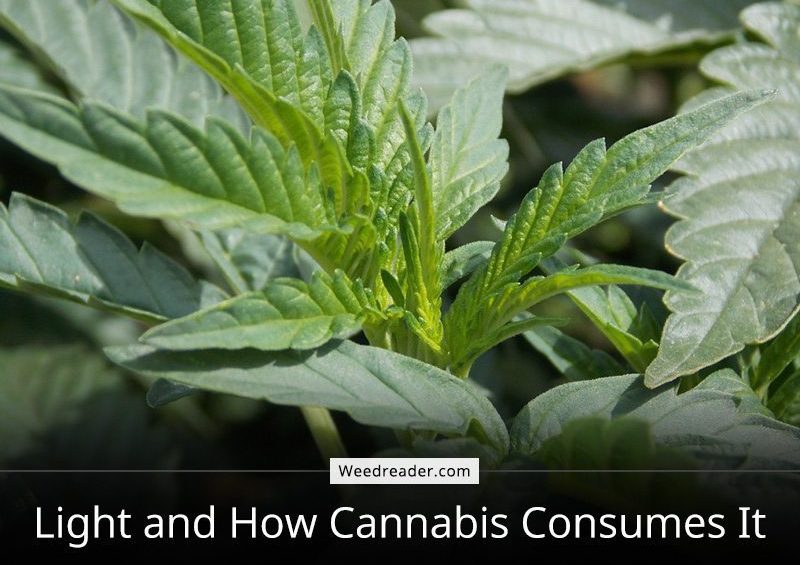
During the early formation of our planet, there was no oxygen to breath, only water and light. This paradise of water and photons gave rise to the first plants. Not like the orchids and redwoods we are accustomed to today, early plants were mostly algae in the early oceans. These early plants developed a way to transform light into food.
By using sunlight to convert light energy into chemical energy, plants were able to store it for later use. Although photosynthesis is performed differently by different species, the process always begins when energy from light is absorbed by proteins called reaction centers that contain green chlorophyll pigments.
In plants like cannabis, these proteins are held inside organelles called chloroplasts, which are most abundant in leaf cells. In the light-dependent reactions, one molecule of the pigment chlorophyll absorbs one photon and loses one electron. This electron is passed to a modified form of chlorophyll called pheophytin and the process propels a chain reaction of life.
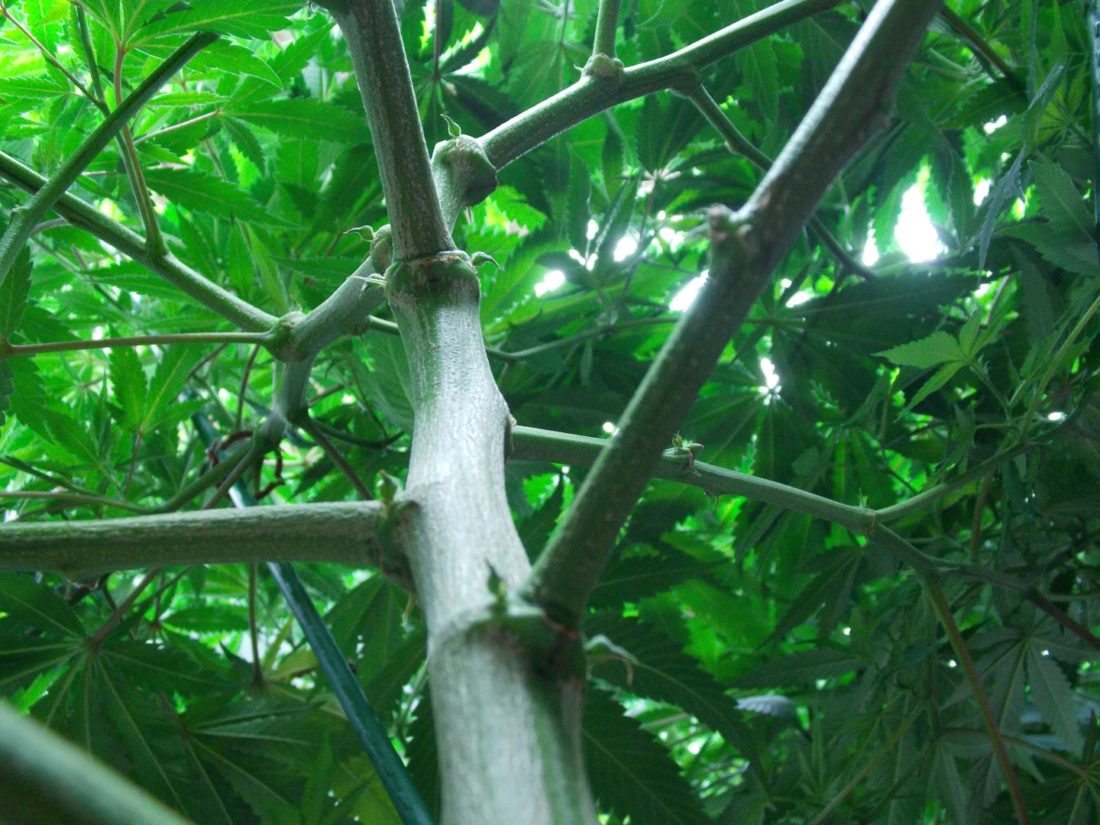
Yet some wavelengths of light are more useful to a plant than others. Wavelengths that the plant uses a lot of get absorbed into its leaves and stem while wavelengths they don’t use get reflected back. We only see plants as green because they don’t use green light energy. They reflect the one color they don’t photosynthesize so we perceive them as green.
Because of how plants evolved their ability to photosynthesize, different wavelengths are needed in greater amounts at certain stages of a plant’s growth, such as the blue and red. Light high in the blue range enhances vegetative growth, while red light strongly influences flowering and fruiting.
What we perceive as visible light is comprised of seven main colors. All the odd colors we see like pinks, browns, and beiges are just mixtures of other colors. Our eyes can only register wavelengths of light are within the 400 to 700nm range. Below 400nm, we move towards ultra violet, x-ray and finally gamma rays. Above 700nm is infra red, then microwave and finally radio waves.
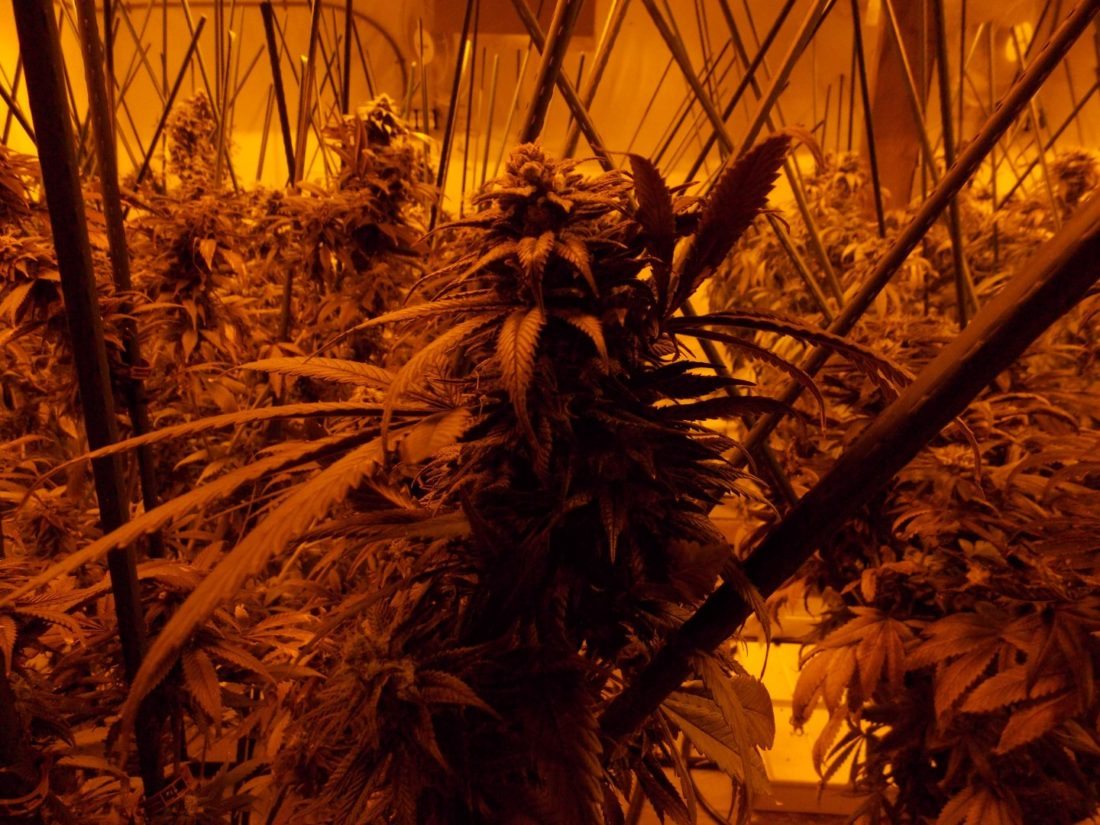
Nanometres (nm) are a measurement of light waves. Each degree in Kelvin (°K) rates the ‘temperature’ of a light and offers an indication to the peak nanometers (nm) or color within the spectrum. The lower the nm, the more blue the light appears while higher numbers look red.
Marijuana uses light from approximately 420nm through to 750nm. But what does that mean? To understand the unique diet of cannabis (and make those real yield gains) we need to create the ideal environment for the plants.
Giving them just any light simply won’t do if the goal is heavy crops (and who doesn’t want that?). Normal incandescent bulbs produce more high energy wavelengths like infra red (heat) and midrange light (550-650nm) than anything else. Anyone who has tried to grow a plant in a room lit only by incandescent bulbs can attest to their poor performance so avoid trying to grow with them.
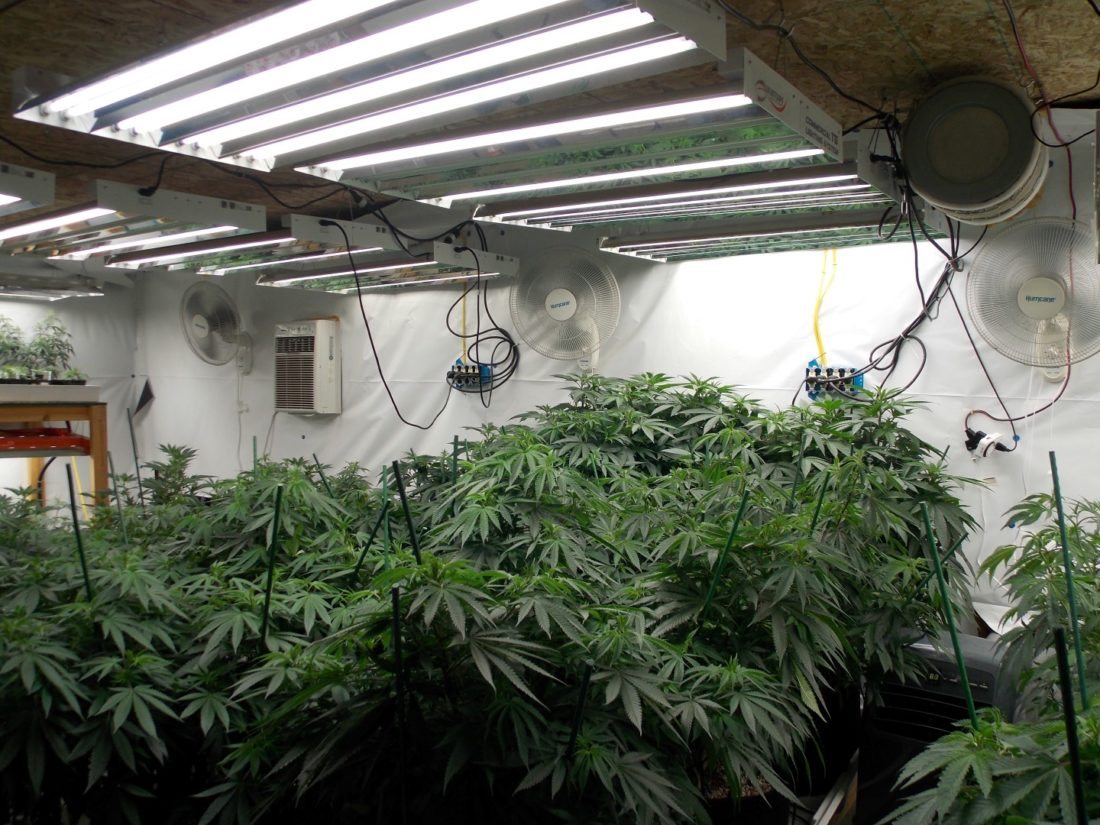 Even light in the right wavelength may not have the right amount of lumens.
Even light in the right wavelength may not have the right amount of lumens.Cannabis need light from the right part of the spectrum with the right amount of intensity to encourage proper yet fast growth. Marijuana evolved to grow under sunlight which changes intensity over the seasons. Young weed plants can be easily burned if put under the same intensity of light as a mature ones.
For this reason, many cultivators use different lighting techniques for the different stages of plant growth. Fluorescent lights produce the right wavelengths for growth but lack the intensity of other lighting options making them the standard for use with seedlings and young clones. HPS (High Pressure Sodium) and MH(Metal Halide) are industry standard lighting options that are used during vegetative and flowering stages although LED (Light Emitting Diode) are quickly establishing themselves as premium lights in the market.
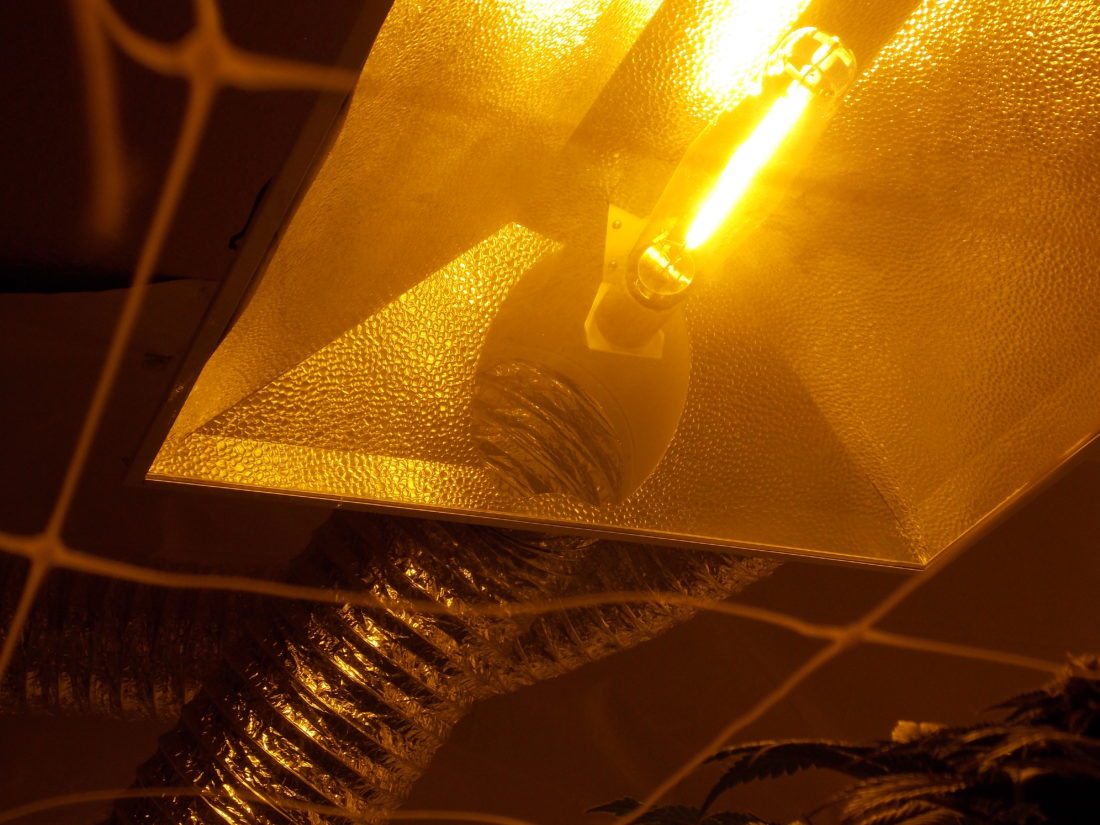
HPS lights offer light from approximately 540 through to 700 nm, typically yellow, amber and red light so they are great for flowering/budding marijuana. These lights tend to burn hot and need to be ventilated as well as hung from a decent distance from the plants. This makes having a tall area to grow in a priority. Luckily, the light produced by HPS lights penetrates deeply into thick canopies which is perfect for the flowering stage when buds and leaves are competing for room.
MH lights offer light from approximately 350 to 550 nm in the blue, green to yellow range. However exact levels depend on what lamp your purchase as some lamps are ‘cooler’ and others a bit ‘warmer’ than average. MH lights are good for the vegetative stage but not as much for the flowering/bud stage.

LED grow lights can have a mix of LED diodes in a single ballast or specialized ones. This gives cultivators one more variable to work with but it also opens up a whole world of adjustment. With the increased lifespan of diodes over bulbs, reduced energy consumption and lower heat production, it is easy to see why cultivators are switching to LED.
While LEDs are far more efficient then HPS or MH lights (with almost 30% savings reported on average) they come with a significantly higher initial price tag. Small projects and weekend cultivators may not want to shell out the cash needed to obtain a quality growing LED but commercial outfits normally opt to go with the reduced energy consumption and quickly make back the difference in initial price.
LEDs also have the benefit of not needing specialized heat venting as they produce almost no heat. While HPS and MH lights require ducting, fans and additional controllers, LED lights don’t need any of that while providing a dynamic mix of color temperatures. The best LEDs are full spectrum and use some blues, some reds and a very stable white to create broad (full) spectrum LED grow light. These are the new breed of grow light and cover the full light range from around 420 through 750 nm.
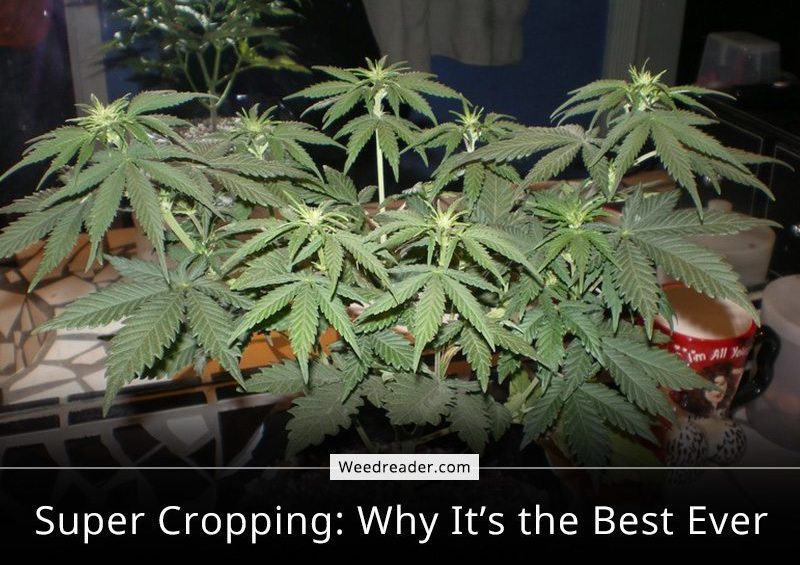
Super cropping (also supercropping) is the name for a High-Stress Training (HST) technique where the plant is stressed by slightly hurting it in a strategic way. Super cropping is basically just a coined word for growing a bush-like plant by crushing its stems instead of cutting them off. This technique can be performed on virtually every cannabis plant (excluding autos) and can actually be done multiple times during the vegetative process.
Super cropping is most effective with 600 watt lights or bigger because they allow good light penetration. If growing a bush style plant from clones, it’s important to top the plant right after the clone roots. Doing so will provide a strong base where the extra branches start low on the trunk.
Cannabis plants become stronger after recovering from trauma. Things like bent or crushed stems can become even larger and stronger than undamaged stems. If the main cola (flower) of a cannabis plant is removed, the plant will put energy into growing the remaining colas. Each super crop basically doubles the number of potential colas on a plant.

After super cropping the plant will grow bushier, produce more buds, and possibly even produce more THC! This is how the plant naturally responses to danger and protects itself. Growers take advantage of this technique to get bigger yields and more potent buds than would be produced otherwise.
If the goal is to harvest the biggest and the best buds, you should actively stress the plant in a way that will result in an increase in the production of cannabinoids. If the aim is to get a better harvest, “super cropping” is by far the best method of stressing your marijuana before harvesting.
Of the 483 known compounds in Cannabis, Tetrahydrocannabinol (THC) is the primary psychoactive component of cannabis and produced in the plants trichomes. The second major component is CBD. It is also considered to have a wider scope of medical applications than THC because of study results in treating epilepsy, anxiety disorders, nausea etc. Both are produced in greater amounts by plants that have been properly super cropped.
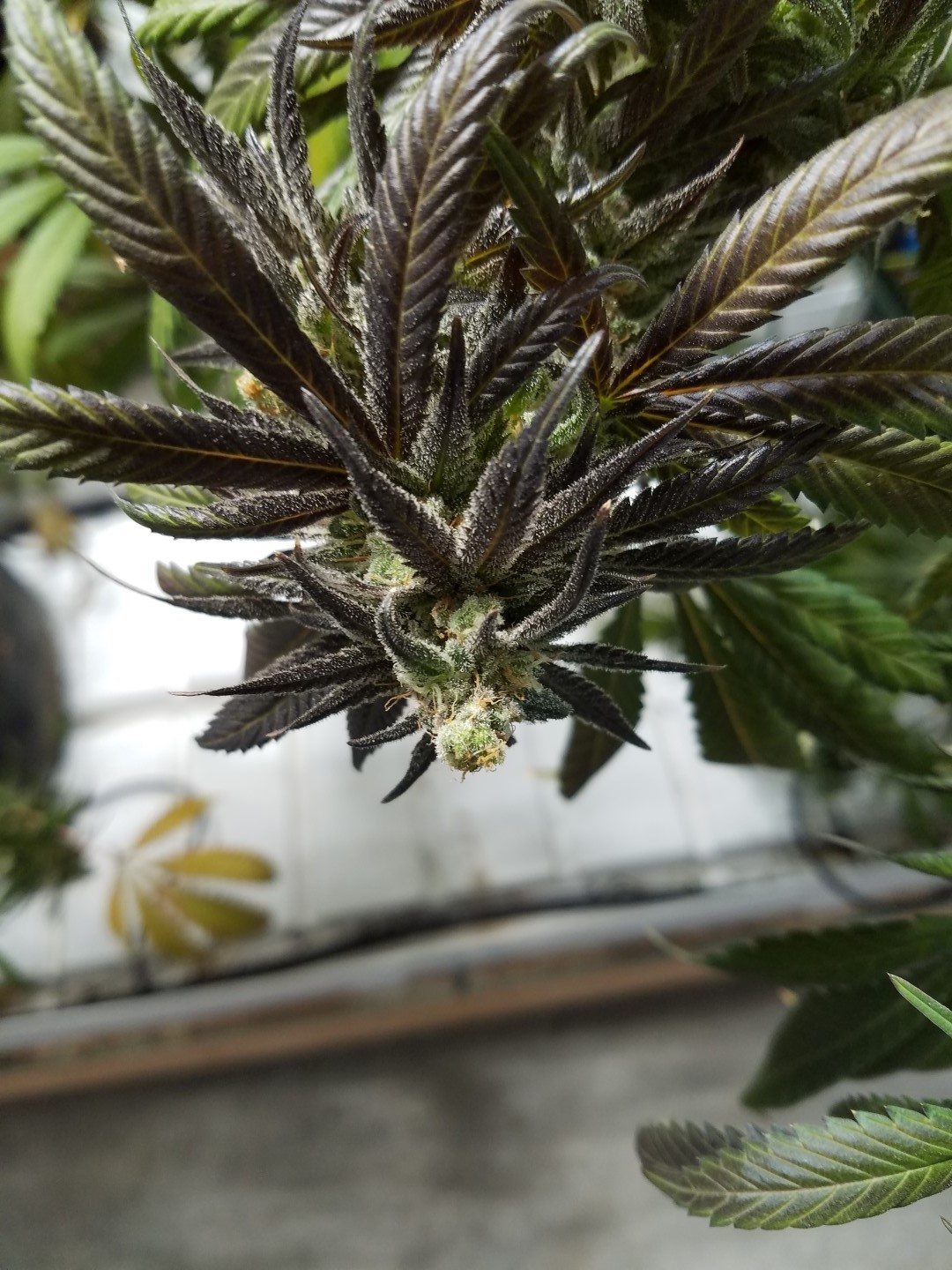
Super cropping works along with Low Stress Training, or LST. LST is the simple process of training your cannabis plant to grow laterally. This is usually done by tying down the branches of the plant to stop it from growing vertically. Light is one of the most important factors contributing to the growth of a plant so when it comes to cannabis, light dictates when a plant produces its flowers and how well those individual buds develop.
The main idea of super-cropping is to get marijuana to expose as many branches as possible to direct light and induce the plant to produce more leaves, buds and flowers. To apply the method, a certain amount of stress must be applied to your plant.
By exerting gentle pressure firm enough to slightly damage the tissues, a grower can intensely escalate marijuana yields. Because of the special stress response that takes place within the plant, the risk of infection or splitting is also minimized.

Choose the most suitable branches you want to super crop. Start by doing only a few branches at a time, you will make sure that the plant reacts well to the stress technique. Remember that the goal is to stress the plant, not kill it.
After selecting the spot, gently hold the branch between the thumbs and forefingers of your hand and while gently exerting firm pressure, soften the inner tissues and carefully roll the branch between your fingers until stem feels limp in that spot.
A severely damaged branch may be beyond natural repair, especially if the branch is visibly split. Applying grafting tape or Duct tape will help to strengthen the damaged branch during the healing process.

When it’s time for a plant to flower, the size of the buds it produces is largely dependent on light exposure. The more light (in the right wavelengths) a certain part of the plant canopy gets, the stronger and bigger it is likely to be. That’s why the crown of a plant usually has denser, bigger flowers than the bottom.
Super cropping allows you to manipulate a plant and its canopy for maximum exposure. By ensuring the entire canopy gets evenly exposed to light, growers encourage it to build big, dense buds. This is true even in areas normally be covered by foliage.
For its own survival, the plants growth mechanism will cause it to ‘set’ the break and keep the limb in place after it is done healing. Arranging super cropped tops horizontally creates an environment for increased bud production as colas that would have been under the main cola are exposed to direct light.

Be really careful because this method is designed to induce the plant to throw out a greater number of colas and new leaves. Being too aggressive can have seriously negative results. Following the logic of nature, this method works because the plant is deceived into believing that it is under attack by some force and therefore it will compensate.
In the process of healing, the branch will grow a protective nodule to strengthen the damaged area. This ensures that transpiration of essential nutrients and water are not restricted. Growing the nodule is a key step of maintaining the overall health of the plant.
Since this technique requires time for the plant to heal, the best time to super crop is in the plants’ vegetative or growing stage. During the second or third week of growth will likely be most effective time. How will you know? When the plant produces vigorous new branches but has not yet fully started the flowering stage, it’s time.
By super cropping, cultivators enjoy shorter and more controlled plants that produces a great number of branches and buds. Even though the plant needs more time to recover, proper super cropping does not retard the growth of the plant like pruning of the tops or picking leaves to induce growth.

How to Roll While Driving
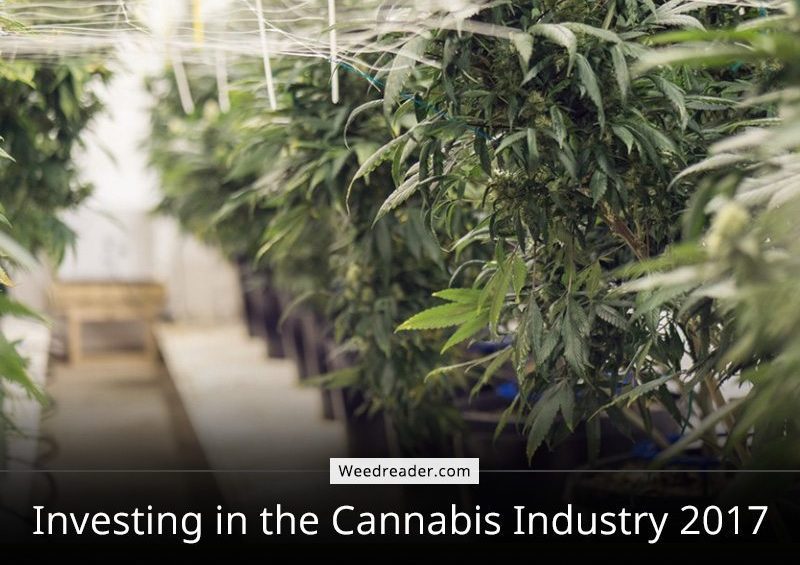
Investing in cannabis is making some major money with one especially impressive company posting gains of well over 2,000%. This despite how fraught with risk this industry is. Since marijuana is still classified as a Schedule I substance with “no currently accepted medical use and a high potential for abuse,” according to the federal government, there are still some hurdles to overcome.
The National Commission on Marijuana and Drug Abuse issued a series of reports concluding that marijuana was “less a serious threat to public health than a sensitive social issue and recommended changes to federal law that would permit citizens to possess a small amount of it at a time, while still maintaining that the drug should not be legalized.” Yet investing remains risky because the people in power refuse to be moved to action.
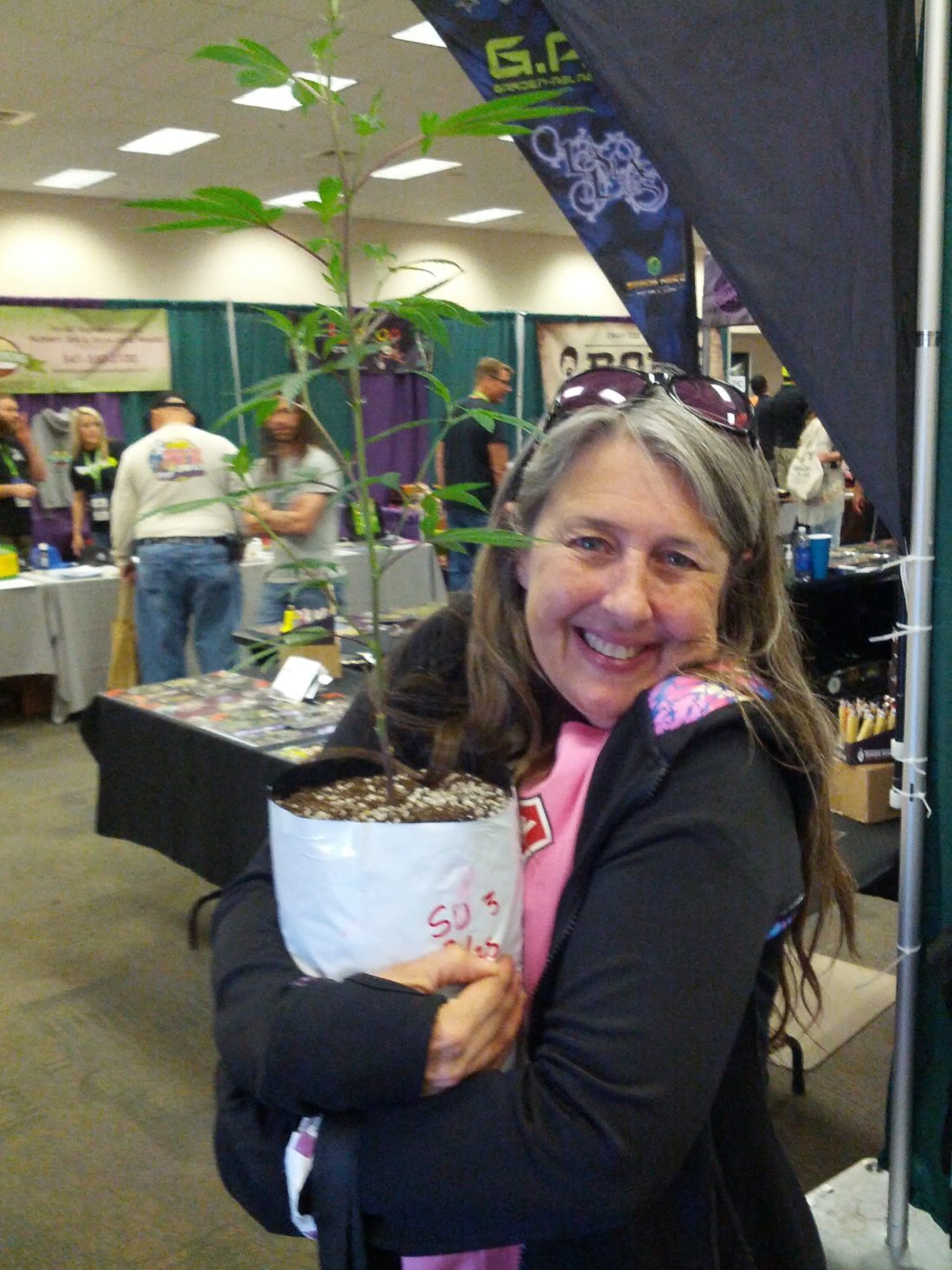 Ackrell Capital projects that the cannabinoid-based pharmaceutical market could clear $50 billion annually. Investors took special not of the prediction due to the explosive growth the industry has seen so far. They make sure to include plenty of caveats in their report that basically boil down to legalization=money.
Ackrell Capital projects that the cannabinoid-based pharmaceutical market could clear $50 billion annually. Investors took special not of the prediction due to the explosive growth the industry has seen so far. They make sure to include plenty of caveats in their report that basically boil down to legalization=money.
AbbVie (ABBV) is ahead of the game in medicinal marijuana field because its drug (Marinol) is already been approved by the Food and Drug Administration and in the market. Marinol is mainly used to relieve nausea and vomiting for chemotherapy patients. It has also been prescribed for AIDS patients to help stimulate appetite.
If you want to talk about AbbVie, let me just say that it has had 44 years of consecutive dividend increases. Over the past three years alone, the dividend has grown by 12.5%. the 4.13% dividend yield is considered attractive for income investors.
Just because they were first to the market doesn’t make them invincible though. Company revenues, gross profit and net income have been stagnant during the last four quarters. If Marinol can raise profits, AbbVie and others like it could be treated as an income play rather than a growth stocks for 2017.
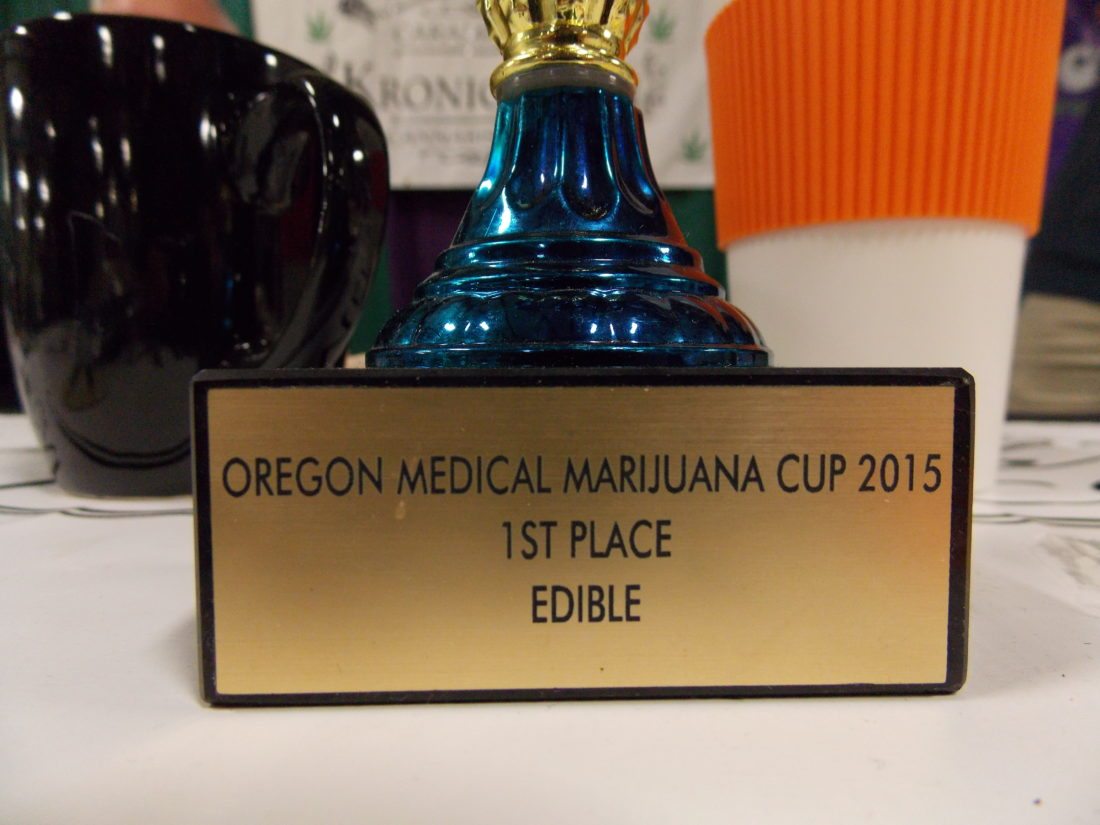 Support for use of medical marijuana is rapidly expanding along with investing opportunities. After the November U.S. elections, 28 states plus the District of Columbia now have legalized use of medical marijuana. A handful of states have also chosen to allow recreational use.
Support for use of medical marijuana is rapidly expanding along with investing opportunities. After the November U.S. elections, 28 states plus the District of Columbia now have legalized use of medical marijuana. A handful of states have also chosen to allow recreational use.
Legalization should diminish some of the institutional barriers for companies investing in the marijuana industry. Although we can see how slow the movement is by looking at recent court decisions about drug testing. The advancement of legalization on a state level presents a special opportunity for investors but at great risk.
Weed’s mis-classification as a schedule-I compound creates restrictions for patients in non-weed-friendly states. Not to mention how much of a damper it puts on investors’ plans. The chief regulator of Wall Street (Financial Industry Regulatory Authority or FINRA) blocked a S-1 filing from weed companies attempting to go public and trade stock. The ban will remain in place until the drug is re-scheduled.
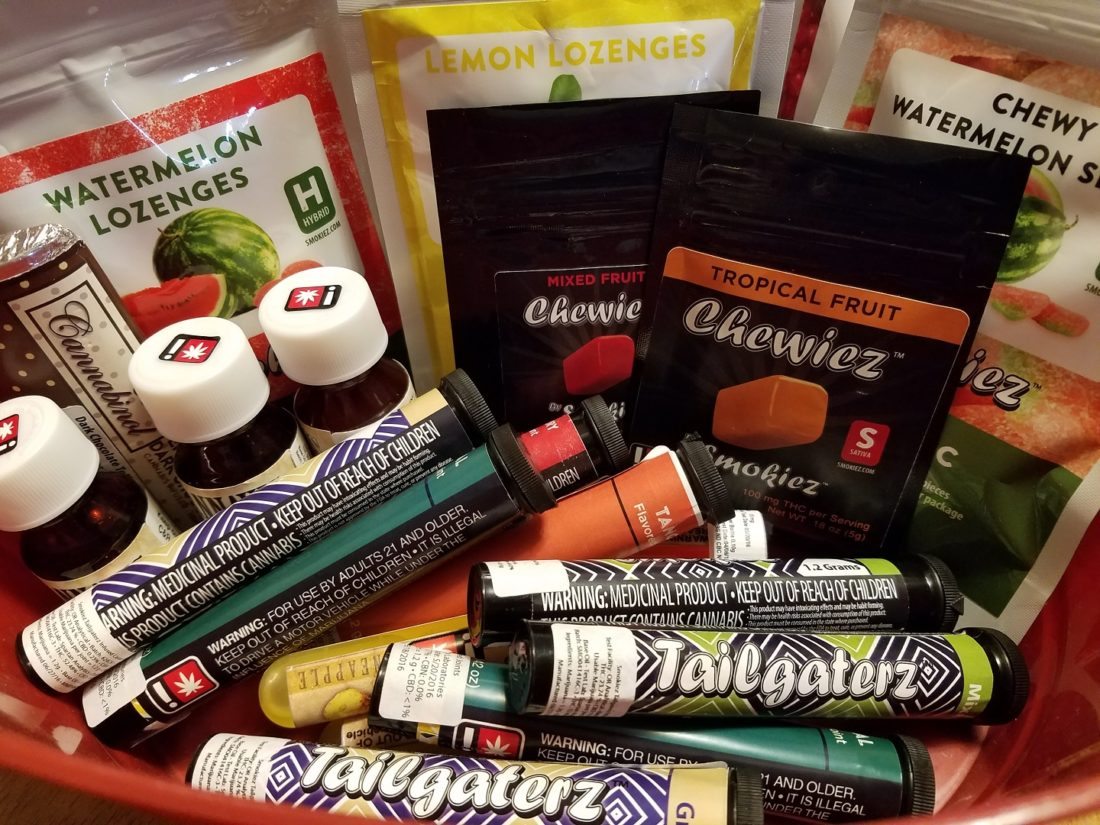 While opportunities exist, current realities paint a stark picture. The U.S. Food and Drug Administration has approved a whopping total of three cannabinoid drugs. It took seemingly forever for another cannabinoid to join Marinol and Cesamet in the medicine cabinet.
While opportunities exist, current realities paint a stark picture. The U.S. Food and Drug Administration has approved a whopping total of three cannabinoid drugs. It took seemingly forever for another cannabinoid to join Marinol and Cesamet in the medicine cabinet.
In July of 2016, the FDA gave the go ahead for Insys Therapeutics’ (NASDAQ:INSY) Syndros to join the party. Like Marinol, the active ingredient of Syndros is the synthetic cannabinoid dronabinol. And don’t think that only drug companies are trying to get in on the action.
Investors sent shares of Scotts Miracle-Gro Co. up 48 percent last year when they saw the lawn-care company as a relatively safe way to capitalize on the cannabis trend. It sells fertilizers, lighting and other supplies for hydroponics that are used by most indoor cultivators.
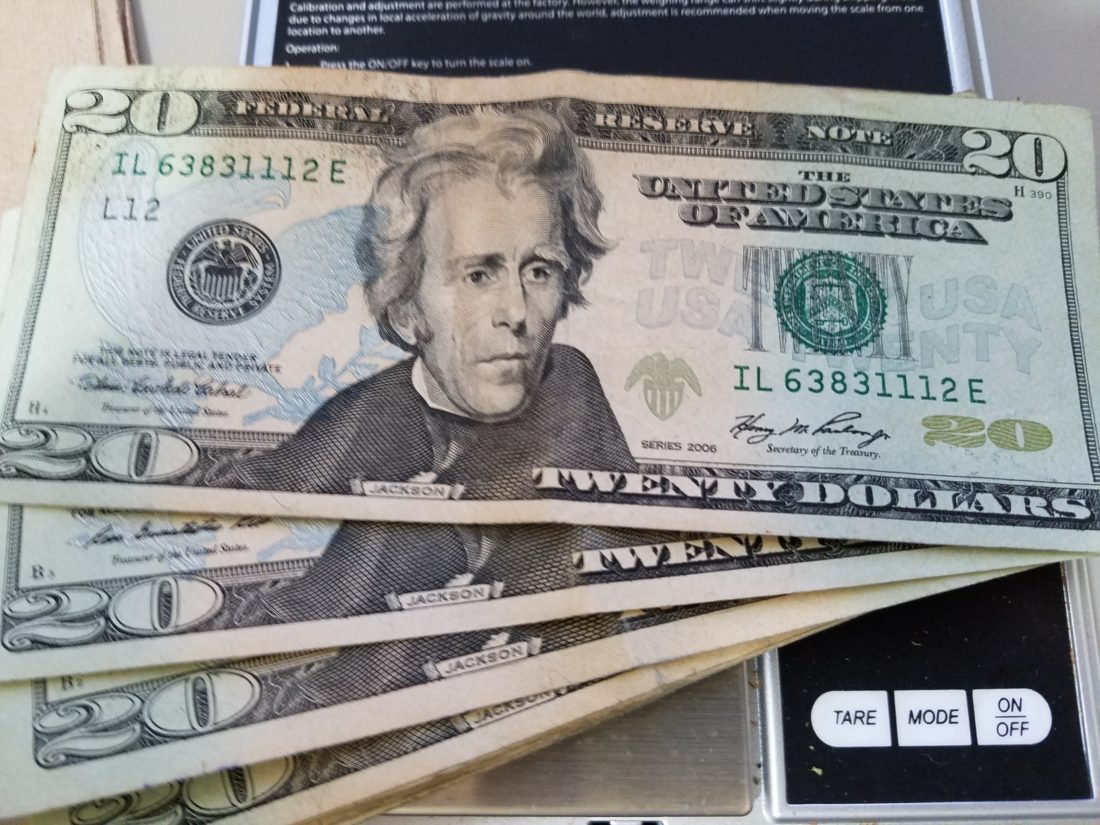
A very important fact for investors considering investing in marijuana to remember is who the next attorney general is. And the person who got the nomination to fill that role was Alabama Republican Sen. Jeff Sessions. A man who is an adamant opponent of legalized marijuana.
In a Senate hearing last April, Sessions cited a 20% increase in the traffic deaths in some states where marijuana has been legalized to show the drug is a problem. His continued vigorous attempts to demonize cannabis users signals major disappointment for those hoping for banking reform.
Marijuana companies have continued to struggle with limited access to basic banking services since most banks fear federal prosecution for dealing with pot businesses. Being forced to operate on a cash-only basis is a security concern and an expansion inhibitor for any business. With Sessions taking the helm, there is little hope for meaningful pressure to improve access to banking services. Additionally, marijuana businesses must pay tax on their gross profits instead of net profits. This is because they’re disallowed normal corporate income tax deductions.

It has been said that getting rich during a gold rush is to easiest when you sell shovels. With that in mind, the best figure for investors trying to turn a profit from the “marijuana rush” are the companies that have zero marijuana-related products. The smartest play might be in companies that have the potential to benefit by serving people and companies that do sell cannabis.
But before you invest in any company, get as much information about that company as you possibly can. Find out if they are a legitimate company with a good management team. Look into who’s running the company and at the company’s finances. Don’t be afraid to go over the balance sheet, the cash flow, the income statement, and the shareholder’s equity.
Look at all of the info you can before making a decision. Call the nearby Chambers of Commerce, find out if they know the people or company. Don’t forget to look at the other officers and management to make sure the engine is firing on all cylinders if you catch my drift. Do all the research you can but don’t forget to talk to your financial advisor as well before pulling the trigger.
The early bird doesn’t always get the worm.
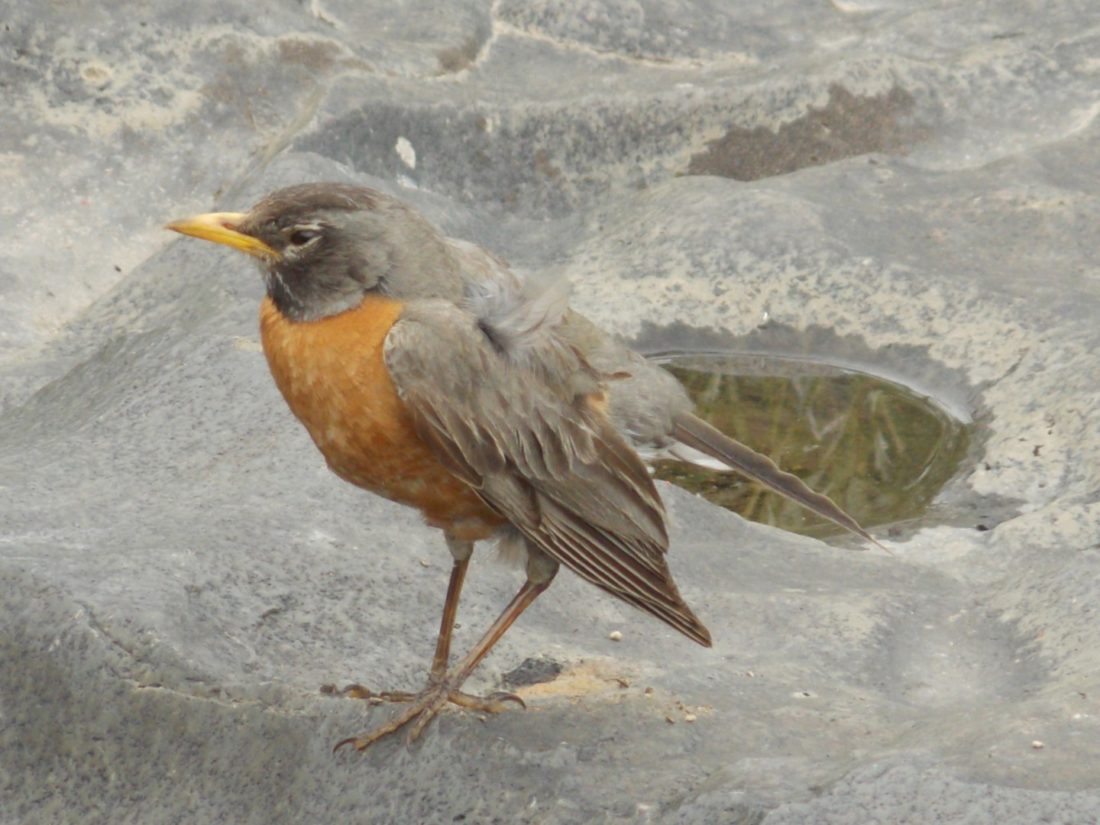 Companies are making serious efforts to develop effective medicines using on cannabis. These companies deserve all due diligence before investing in any of them. Understand that investing in potential is risky and any of the drugs discussed in this article could fail or disappoint. Some medicinal marijuana stocks will undoubtedly succeed in 2017, so research and be vigilant when navigating this exploding industry. But don’t forget all the good that cannabis can do.
Companies are making serious efforts to develop effective medicines using on cannabis. These companies deserve all due diligence before investing in any of them. Understand that investing in potential is risky and any of the drugs discussed in this article could fail or disappoint. Some medicinal marijuana stocks will undoubtedly succeed in 2017, so research and be vigilant when navigating this exploding industry. But don’t forget all the good that cannabis can do.
Cannabinoids have been found to have potential in treating over 40 medical issues including cancer, chronic pain, epilepsy, and glaucoma. Companies developing marijuana-related compounds rarely focus on cannabis alone. Be aware that some “mainstream” stocks may actually profit from loosened restrictions on marijuana even if they don’t grow or sell it themselves. Thanks for reading.
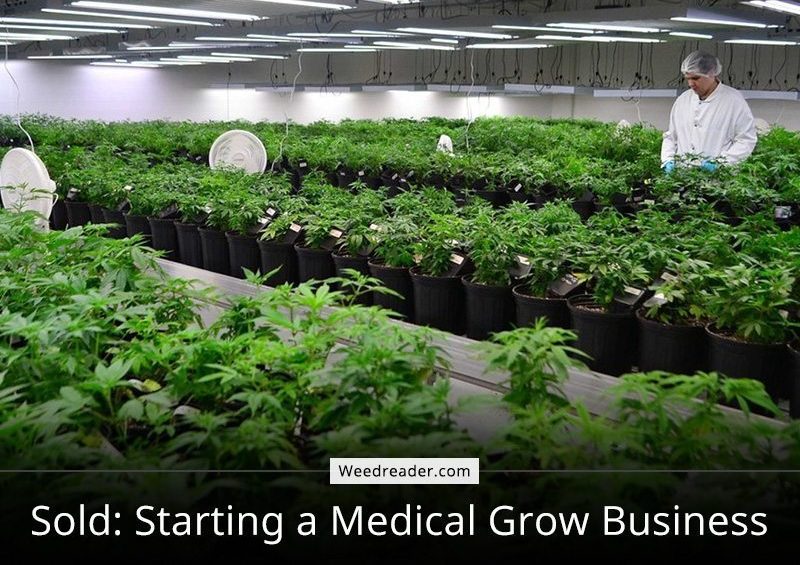
Federal, state and local laws create a vast web of interconnecting rules that are unique to each medical grow (even if they are in the same city and industry). Navigating this miasma is both arduous and tedious by design but is also vital to remaining in business. The best place to start is with your states official rules.
You can’t simply put some seeds in backyard dirt or throw thousands of dollars around and expect to get anything competitive out of it. And this is a competition. The time, effort and skill needed to get a plant from seed to sale is a skill that can be developed over several years. A skilled hand can take a good strain and make it great while an unskilled grower can kill everything.

Growing great herb is a prerequisite to a business based around growing weed. But equally important is the ability to manage costs and duplicate results. It doesn’t matter how much you can sell your product for. If it costs more to produce than what you get, it isn’t a viable business.
“Even if you get your costs under control, you still have to worry about duplication. If you can’t produce the same product every time, you have a problem.” Mike Boynton, the master grower for Oregon Imperial farms told me in an interview. “Changing anything in the environment from fan placement to light duration will change how your plants grow and therefore your bottom line.” The more people and the bigger the farm, the harder it is to control costs. If you can’t get it under control with 5 plants, you will never be able to with 5000.

Getting a business off the ground in the weed industry is a lot harder than most other industries. Cannabis is one of the oldest crops known to man and you can bet there are a lot of talented people out there trying to do it better and cheaper than you. Besides having to deal with the standard problems of location and competition, cannabis businesses are heavily regulated and lack traditional support infrastructure like banking services.
Marijuana businesses lack the ability to use banking services because it remains federally illegal. This is not to say that banks refuse drug money. SBC was fined $1.9 billion by the U. S. government for laundering cartel drug money in 2012. Yet the cannabis industry is forced to work on a cash basis regardless of how big the costs.

With over half of the nation having legal weed in one form or another on a state level, there have been many ideas about what should be allowed. Each state has taken different measures to ensure a safe and effective cannabis industry. Some states require seed to sale tracking and vertical integration while others prohibit delivery or drive-thu services.
In addition to rules and regulations about where and how to provide services, there are also rules around what kind of equipment is needed in order to get a license. This further compounds the complexity with many states have a different set of rules for medical grows and recreational operations. As an example, Washington merged their medical grow and recreational grow rules for a single comprehensive program while Oregon kept them separate.

Even in places with ideal growing conditions like Northern Cali, Florida or Hawaii, plants still need water, nutrients and protection from pests/diseases. In areas where the weather is too dry or cold, growing indoors becomes a necessity. The cost of equipment pales in comparison to the cost of keeping the growing environment perfect.
In addition to lights; pumps, timers, fans, filters and air conditioners all use electricity. Keeping the juice flowing can be a challenge in itself. Grows with more than one room may even need to have a more powerful line run by the electric company to keep from blowing transformers. All of these little additions add up quickly and can quickly eat up all the potential profit.

If you plan to operate a successful company growing a federally illegal substance, you need to have some specific talent on your team. This team needs at least a lawyer, an accountant and a lobbyist to run interference while the head grower does their work. Without someone covering each area, the chance of getting blindsided is astronomical.
Find someone who specializes in canna-based business compliance and criminal cannabis defense. Ask others in your area who they recommend. Don’t forget to check online databases like www.martindale.com, www.avvo.com, www.justice.org to name a few.
Look for someone with experience in the industry. Overly “creative” accounting can get you in hot water so make sure you can trust them. In addition to searching online for local tax professionals, ask colleagues for referrals. Asking others in your area who they use and why is also a great way to narrow the search for the right accountant.
Look for someone with the time and energy to represent your cause. Their job is to keep an eye on local and statewide changes that pertain to your business. They are also there to help prevent others in the community from effectively banning your business or engaging in sneaky tactics to close you down. There are no lists/registries for this, gotta tap into that network to find the right person..
Look for someone with botany experience. Many master gardeners hang out in local hydro stores or are at least known by them. Don’t be afraid to ask questions and be picky. This is the person who will dictate the initial and final quality of the product and choosing the wrong person can have dire consequences.
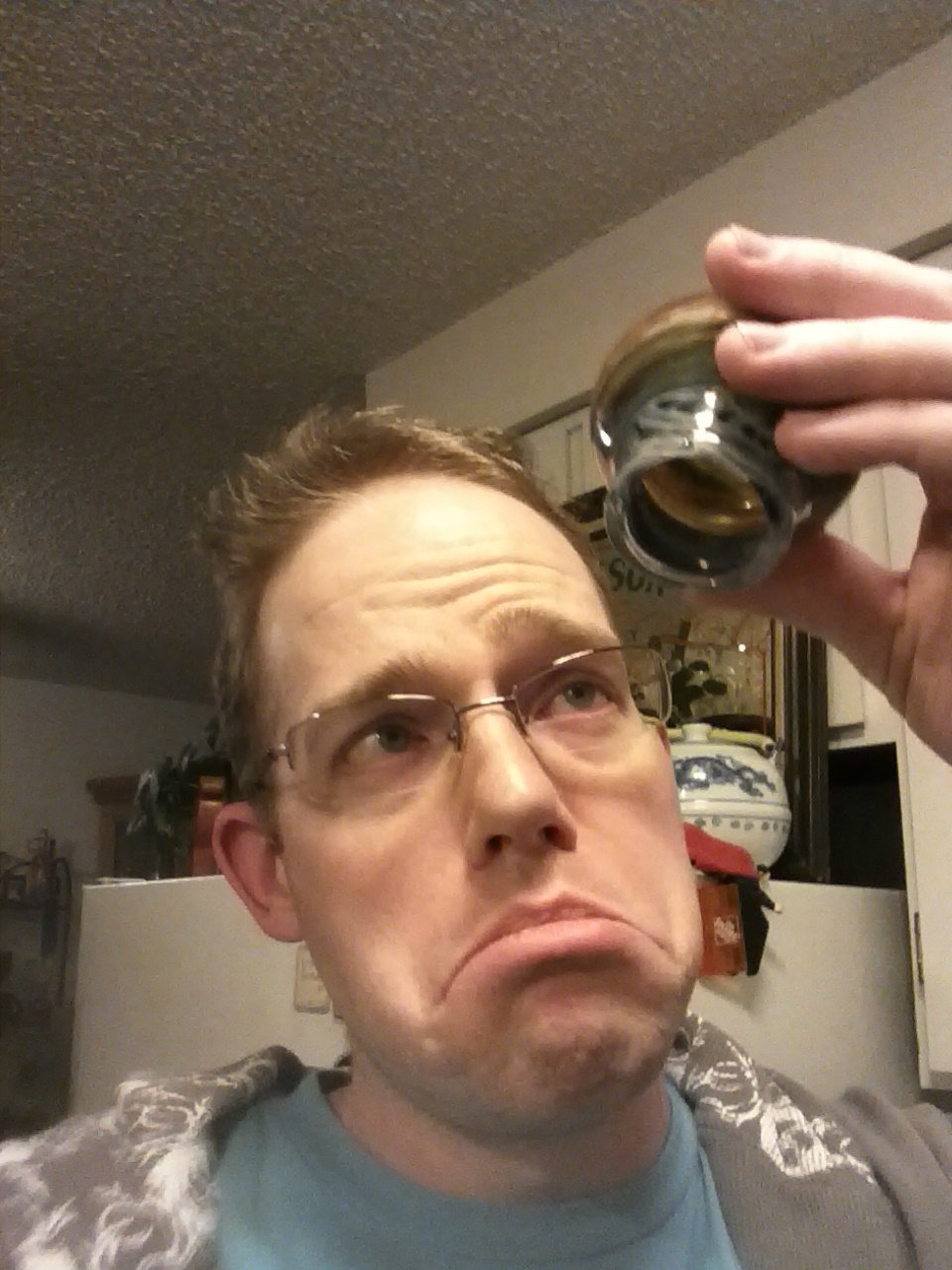
Many states ban the operation of any marijuana based business (including a medical grow) within a certain radius of schools. But most states don’t ban schools from opening near a marijuana businesses. There is normally nothing explicitly stopping a preschool from opening next to a dispensary or grow location and putting you out of business.
A good team is the difference between closing up shop or staying open for years. It does you no good to spend millions of dollars on a medical grow business just to have a preschool open next door a week later and shut you down. Better to have the staff on hand to stay open and deal with the issue before it gets finalized than not.

Besides schools randomly popping up, there is a lot to consider when starting a grow business. The first thing most growers work out is where they plan to grow. Most medical grows are done on a personal consumption scale. If the plan is to make it profitable, it takes a bit more consideration.
Because cannabis remains federally illegal, landlords are almost as hesitant as banks are to work with weed entrepreneurs. Even in the case of a medical grow, it can be almost impossible to get permission to start. In most cases, growers need to own the land/building they plan to operate in or receive written permission from the land owner before getting licensed.

Each state has very specific rules on which types of security are needed for a medical grow to remain in compliance. States may require barriers like walls be erected around grow sites. They also might require closed circuit cameras linked to cloud backups but it depends.
Whole sectors of the economy have been dedicated to the outright eradication of cannabis for decades (I’m looking at you Big Prison, Pharma and Tobacco). As cannabis moves from illicit trade to regulated market, there is bound to be pushback from entrenched interests. Even a medical grow can face opposition from local religious or political groups that don’t like cannabis.

More and more people are getting in on the Green Rush and starting to grow cannabis. Like the Gold Rush that sparked westward expansion, the hype and obvious wealth being generated is causing a migration of talent and willpower. Fortunes are waiting to be made by talented and driven individuals willing to put in the work.
In the end, most of the states where weed has been legalized were ballot measures which means they were supported by voters. With the majority of the population clearly supporting cannabis reform, cannabis is primed to continue growing for years to come. Getting a good team will make every other part of the process easier.
Or do you think I’m off my rocker? What advice would you give to someone just getting started? What do you wish you knew before starting a medical grow? Let us know in the comments down below. We would love to hear your take. And as always, thanks for reading.